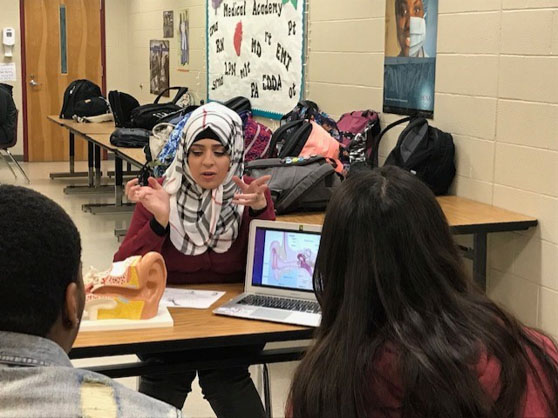Diversity Pipeline has already started bringing in talented students
By Isabel Phillips
CHS Contributor
Just a few years ago, Jade Smith was sitting in her classroom at Bryan Station High School listening to a presentation about Communication Sciences and Disorders (CSD).
Standing in front of the class was Anne Olson, an audiologist and a faculty member in the College of Health Sciences at UK. She was accompanied by a group of CSD students from diverse backgrounds who talked about UK's CSD Program, and specifically, careers in communication sciences and disorders.

Olson told the group told the class that a CSD degree from UK can offer many opportunities for those wanting a career in the broad field of health care. Through CHS’ undergraduate and graduate CSD programs, students will gain the necessary knowledge and skills to pursue clinical careers in speech-language pathology or audiology, as well as related careers in education, health care or rehabilitation. They then broke into small work groups with hands-on activities that related to these careers.
It opened Jade’s eyes to a world of new opportunities. She had little prior knowledge about the topic, but she wanted to know more.
“It was a very comfortable space for everyone to learn and I left feeling very intrigued and interested,” said the 18-year-old Lexington native.
When the time came for Jade to start thinking about colleges, she already had a head-start.
The COVID-19 pandemic had caused the world to change, and it made Jade more comfortable with the idea of staying close to home. She was offered scholarships at UK, so she chose to become a Wildcat — and to major in CSD.
“I’ve always loved being challenged when it comes to learning new things, and I knew pursuing Communication Sciences and Disorders would fulfill that challenge,” she said. “I also have a deep love for communication and wanted to continue that throughout my educational career.”
It is exactly the effect Olson hoped their presentation would have, as it is part of a CHS mission to diversify health care professions by partnering with, and empowering, underrepresented students.
The Bryan Station classroom visit was the first step of an undergraduate research project that started in Spring 2016 and asked “What are the best practices for recruiting and retaining students from underrepresented minorities into health science professions?”
By the following fall, CSD established a small working committee of students from diverse backgrounds, faculty and staff to identify local high schools with high percentages of students who were from underrepresented backgrounds. They called it the Diversity Pipeline, and they created an engaging presentation about audiology and speech language pathology, developed small-group hands-on activities about CSD, made personal connections with students and provided an opportunity to follow up through email or a campus visit.
Studies show that less than 10 percent of health care professionals are comprised of racial and ethnic minorities, while just 8 percent of speech language pathologists and audiologists are comprised of racial and ethnic minorities. Further, in many cases, the number of health care providers from diverse backgrounds is no where near the actual percentages of the population they serve, Olson said. It is estimated that right now about 30 percent of the U.S. population is comprised of underrepresented minorities, but by 2050, that number will increase to over 50 percent.
This lack of diversity has inspired all CHS programs to work towards increasing the racial and ethnic minorities in the health care field. By going into Lexington high schools, CHS hopes to educate students on all that CHS has to offer, as well as the possibilities these students can pursue.
The presentation definitely worked on Jade. Now, the UK freshman is a Communications Sciences and Disorders major, with the goal of working with children as a speech language pathologist.
Olson said that was really the whole focus of the idea.
“The initial intent of our efforts was to increase the awareness of the professions of CSD with the hopes that some students might become interested in this as a possible career,” she said. “I was very excited to hear that Jade had actually applied to our CSD program.
“It certainly makes all that effort worthwhile and tells me we need to do more,” she continued. “I’m very pleased that Dr. Randa Remer has been working diligently with CHS students for the past year to design a much more comprehensive diversity pipeline initiative.”